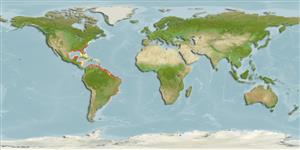>
Siluriformes (Catfishes) >
Ariidae (Sea catfishes) > Bagreinae
Etymology: Bagre: Mozarabic, bagre, taken from Greek, pagros = a fish (Dentex sp.) (Ref. 45335).
More on author: Mitchill.
Environment: milieu / climate zone / depth range / distribution range
Ekologi
laut; payau dasar (demersal); kisaran kedalaman 0 - 50 m (Ref. 5217). Subtropical; 43°N - 34°S, 98°W - 34°W
Western Atlantic: coast of Gulf of Mexico, Cuba, western margin of the Caribbean, and the northern margin of South America. Sometimes in rivers and estuaries.
Length at first maturity / Size / Weight / umur
Maturity: Lm 44.8, range 50 - 63.5 cm
Max length : 69.0 cm TL jantan/; (Ref. 40637); common length : 50.0 cm TL jantan/; (Ref. 3265); Berat maksimum terpublikasi: 4.4 kg (Ref. 40637)
Sirip dubur lunak: 22 - 28. Maxillary barbels, first ray of dorsal fin, and first ray of pectoral fin extended as long, flat filaments. 1 pair of barbels on chin.
Mainly marine but enters brackish estuaries with relatively high salinities (Ref. 5217). Opportunistic feeders over mud and sandy bottoms (Ref. 27549). Feeds mainly on small fishes and invertebrates. The dorsal and pectoral fins are equipped with a serrated erectile spine, both of which are venomous. Commonly caught by anglers along bridges, piers and catwalks. Flesh considered good; marketed fresh (Ref. 5217). Minimum depth reported taken from Ref. 57178.
Each male carries not more than 50 eggs in its mouth, usually averaging from 15 to 30 (Ref. 205).
Robins, C.R. and G.C. Ray, 1986. A field guide to Atlantic coast fishes of North America. Houghton Mifflin Company, Boston, U.S.A. 354 p. (Ref. 7251)
Status IUCN Red List (Ref. 130435)
penggunaan manusia
Perikanan: komersial; Ikan buruan: ya
informasi lanjut
AcuanBudidaya airprofil budidaya airStrainGenetikaElectrophoresesDiturunkanPenyakit-penyakitPengolahanNutrientsMass conversion
mitraGambarStamps, Coins Misc.Suara-suaraCiguateraKecepatanTipe renangArea insangOtolithsOtakPenglihatan / visi
Alat, peralatan
laporan khas
muat turun XML
Sumber internet
Estimates based on models
Preferred temperature (Ref.
123201): 22.7 - 27.9, mean 24.9 °C (based on 426 cells).
Phylogenetic diversity index (Ref.
82804): PD
50 = 0.5625 [Uniqueness, from 0.5 = low to 2.0 = high].
Bayesian length-weight: a=0.00562 (0.00324 - 0.00975), b=3.16 (3.00 - 3.32), in cm total length, based on LWR estimates for this species & (Sub)family-body (Ref.
93245).
Trophic level (Ref.
69278): 3.5 ±0.5 se; based on diet studies.
Daya lenting (Ref.
120179): Rendah, Waktu penggandaan populasi minimum 4.5 - 14 tahun (Fec = 70).
Fishing Vulnerability (Ref.
59153): Moderate to high vulnerability (48 of 100).
Nutrients (Ref.
124155): Calcium = 61.8 [31.7, 152.9] mg/100g; Iron = 0.914 [0.564, 1.529] mg/100g; Protein = 17.6 [16.0, 19.4] %; Omega3 = 0.239 [0.137, 0.409] g/100g; Selenium = 29.5 [15.8, 59.0] μg/100g; VitaminA = 10.4 [4.4, 24.8] μg/100g; Zinc = 0.855 [0.571, 1.300] mg/100g (wet weight);
